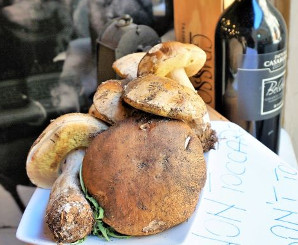Hand-made Pasta
Hand-made pasta is the ultimate in Italian pasta cuisines. Why?
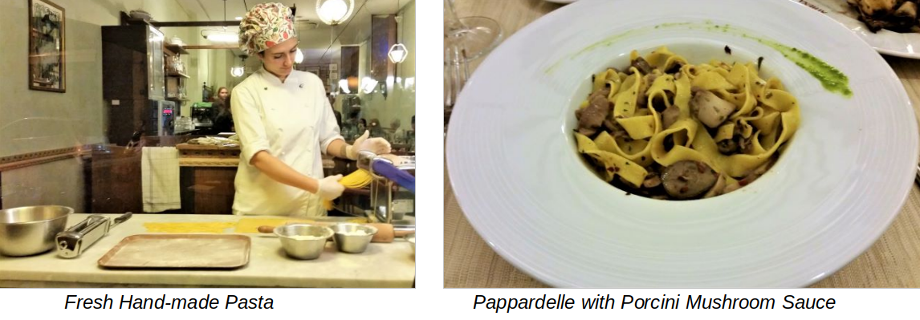
It enables the maker to express him or herself through the art of pasta-making.
Personal preferences in selection of ingredients; style and passion in kneading; firm and flexible … gentle handling … decisive cutting and separating pasta …
And you can taste the difference on first bite!
Most popular pasta in Tuscany is the Pappardelle; large, very broad, flat pasta noodles – like an extra wide fettuccine; pappardelle pasta can be long or short, plain or filled, with or without eggs, with or without fluted edges …
Regional pasta is usually served with a porcini sauce (mushroom), wild boar ragu or a ‘hare sauce’ (as in rabbit variety), known as ‘… on the hare’.
Try it with a porcini sauce – delicate pasta, tender, retaining the ‘el dente’ texture … the tomato based porcini sauce is served with chunks of fresh porcini mushrooms, coarsely cut; lightly cooked in olive oil, garlic and finely chopped parsley … firmness of mushrooms, gives a light ‘spring’ to the palate
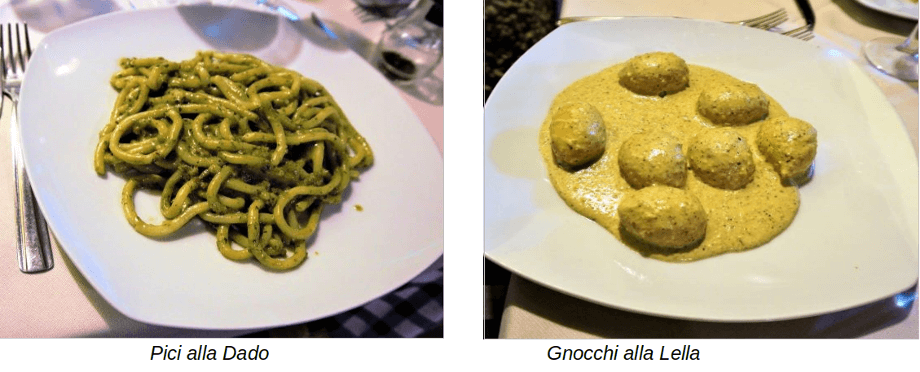
Pici pasta, thick spaghetti, stretched by hand … at times could reach three metres in length.
Rustic, hand-made and stretched; long and irregular, thick and ‘juicy’ in taste, usually made with just flour and water – a poor man’s pasta; and with egg to enrich – reserved for special occasions or Sundays.
Typical Sienese dish; Pici pasta is widely served in homes and restaurants these days.
Dado & Team at Nona Gina’s Satisfied Customers!
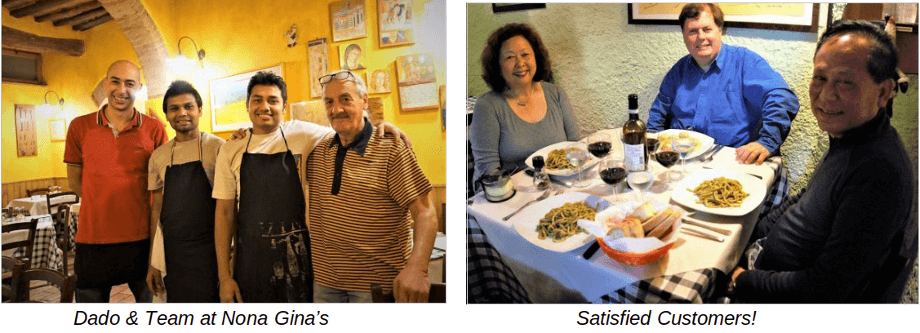
Try ‘Pici alla Dado’ with Dado’s special sauce at Nona Gina’s in Siena – wholesome home-styled meals, without entering your own kitchen … a treat not to be missed when in Siena.
Recommended to us by a local, meals were excellent … so good that we went back the second evening to sample the rest of the pasta menu!
Favoured by locals and tourists, be sure to book; as Nona Gina’s is usually booked out especially over weekends.
Or, try Gnocchi alla Lella – filled with mashed potatoes, parsley, garlic and parmesan … served with yet another speciality sauce created by Lella (wife of Dado) – the pasta just melts in your mouth … over and over again!
Truffle of the White Madonna (Trifola d’Alba Madonna)
Also known as Tuber Magnatum, White Truffle is found mainly in Langhe and Montferrat areas, Piedmont region, countryside around Alba and Asti cities, northern Italy.
Truffles are entomycorrhizal fungi (a symbiotic relationship around root tip of plant); growing amongst tree roots; some species are highly prized as food … in French gourmet circle, truffles are considered ‘diamond of the kitchen’ … well-known in international ‘Haute Cuisine’.
Truffles have been around since 20th century BC; faded into the background in the Middle Ages and re-gained popularity during Renaissance period.
‘Trufficulture’ – the cultivation of truffles is widely practiced these days, where truffles thrive at the foot of select oak trees.
White truffles grown around hills of San Miniato, Tuscany are usually smaller than black truffles, with a maximum12cm (5 inches) diameter and about 500gm (1.1 lb) weight. Pale cream or brown flesh with white marbling, Italian white truffles are held in high esteem, and value in culinary markets.
Harvested in October through to late December by dogs, not pigs; as dogs tend to reduce damage around trees, quality truffles reportedly sold for 4,500 Euros per kilo in 2017 …
However, watch out for some of the ‘truffle-like’ species also available in the marketplace … similar, but not the same …
Truffles have a pungent aroma and should be used sparingly – especially when used fresh.
Generally served raw, shaved over steaming buttered pasta (not oil), salads or fried eggs, paper-thin sliced truffles may be inserted into meats, under skins of roasted fowl, pates, stuffing or in speciality cheeses.

How do you use it?
Most kitchens brush the truffle clean, maybe a gentle wipe with a moist soft cloth, then shave or roughly grated onto dishes.
The skin is the most prized ingredient; usually used for sauces.
‘Truffle has to be King of the dish’, according to a third-generation Italian truffle hunter.
No other flavours should overwhelm it …
And it is absolutely true – served over pappardelle pasta stirred through with porcini mushroom pieces lightly cooked in butter-egg sauce … earthy musky flavour melding with ‘el dente’ pasta … a treat to the senses … and palate.
There are annual truffle festivals held in towns throughout Italy around late November … a celebration not to be missed!
The ‘Cinghiale’
‘Cinghiale’ or wild boar numbers are large in Tuscany – and they feed on almost anything, especially grapes in vineyards.
Wild boar meat is also very popular in Tuscany.
Wild boar hunting is a passion and a tradition – hunting season changes depending on numbers in the area and usually occurs from October to late January in specified areas, on specific days.
Tuscan specialities made with wild boar are celebrated at food festivals or ‘Sagre Del Cinghiale’ throughout the region.
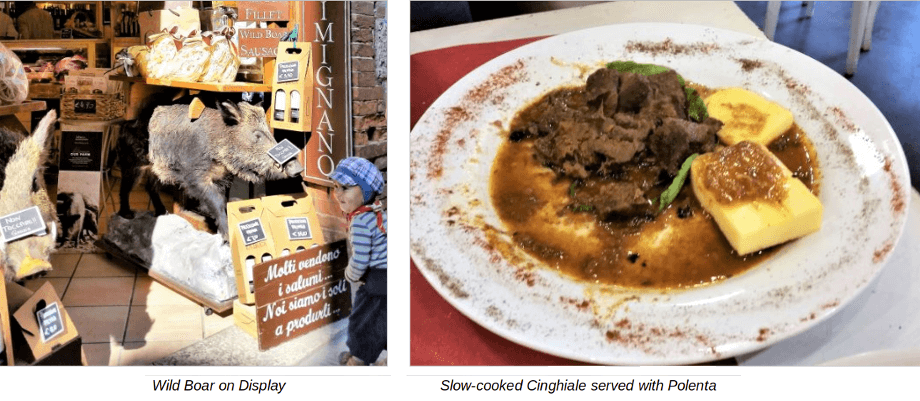
… Wild boar with olives and greens; slow-cooked wild boar stew with bay leaves, rosemary, juniper berries and wine …
‘Pappardelle Cinghiale’ – wild boar meat sauce served clinging to Tuscan Pappardelle … is hailed as one of Tuscany’s national dish.
It is a real treat to enjoy all these scrumptious delights with locals; hear stories of forgotten era; imagining knights and maidens, castles and fortresses, food and more food to sample … with Italian wines of course.
O, what a life in Tuscany!
